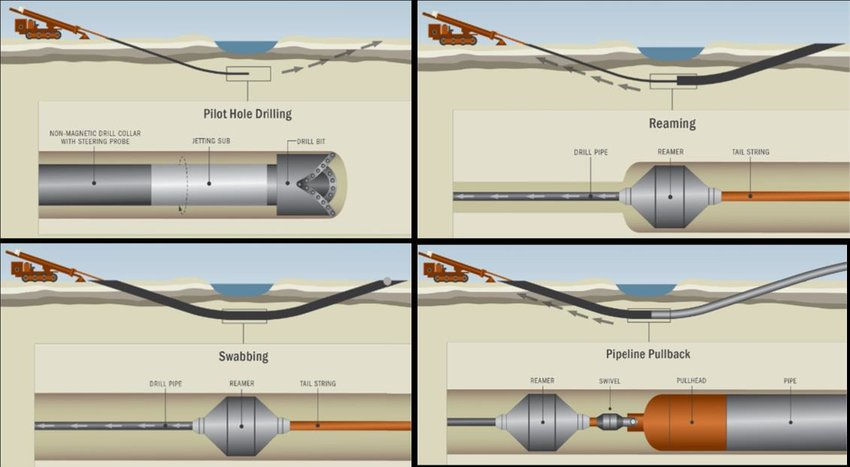Common Challenges FacedDuring Horizontal DirectionalBoring and How to OvercomeThem
- Grid Tech
- Mar 27, 2023
- 3 min read
Horizontal directional boring (HDB) is a widely used technique
for installing pipelines, cables, and other underground utilities. It is
a trenchless technology that changed the entire concept of the
construction industry. The process removes the biggest challenges
that happened in the traditional trenching or open-cut method.
There is no such need for open excavation, road blockage, traffic
congestion, and of course no excess carbon footprint. This method
involves drilling a horizontal hole underground and then pulling the
utility through the hole.

However, like other construction processes, horizontal directional
boring has its own challenges. In this article, we will explore some
of the most common challenges faced during HDB and provide
relevant solutions to overcome them.
Challenge #1: Geology and Soil Conditions
One of the most significant challenges of HDB is dealing with
varying ground conditions. The success rate of a Horizontal
directional boring project widely depends on the soil conditions.
The soil and rock formations can differ from one area to another.
And different types of soils have varying density, strength, and
water contents, which may further impact the boring process.
Unstable soils can cause the borehole to collapse or deviate from its
intended path. On the other hand, hard and compact soils can slow
down the drilling process. Even it can cause excessive wear and tear
on the drill bit.
Solution: To overcome this challenge, the boring professionals
should conduct a thorough geotechnical survey to determine the soil
conditions and site property. Based on the report, they can select
the right drilling equipment, drilling fluid, and techniques to mitigate
the challenges.
Challenge #2: Obstructions
Another common challenge in horizontal directional boring is
encountering the obstructions, like rocks, tree roots, boulders,
underground debris, and more at the project site. All these
obstacles can cause the drill bit to deflect, leading to inaccurate
borehole placement or equipment failure. Additionally, it may cause
delays and cost overruns.
Solution: In order to mitigate these obstructions, it is essential to
conduct a thorough site visit to identify the potential hazards and
take necessary precautions beforehand. Expert drilling technicians
use ground-penetrating radar systems and other detection
technologies to identify obstructions. So, if you want to avoid these
obstacles, it’s time to use specialized drilling equipment, like rock
bits and reamers to break through these obstructions. Remove all
large rocks and debris, stabilize soils, and make sure that the
borehole path is free from obstacles.

Challenge #3: Equipment Failure
The horizontal directional boring procedure incorporates highly
expensive and sophisticated equipment. It involves lots of
specialized drilling machinery, like mud pumps, drilling rigs,
reamers, etc. Therefore, any failure of this advanced equipment can
lead to costly repairs and delays in the project. The failure may
happen due to several reasons. It can be adverse weather
conditions, operator error, mechanical wear, and tear, or even
unforeseen circumstances. No matter what is the reason, you need
to have proper precautions to overcome these.
Solution: Regular inspection and maintenance of these machinery
are essential to prevent sudden breakdowns. You should also have
some backup boring tools to minimize on-site downtime. Most
importantly, you need to train the equipment operators on how to
use the machinery to prevent failure.
Challenge #4: Envrionmental Factors
One of the primary benefits of horizontal directional boring is its
minimal impact on the environment. However, that doesn't mean
that there are no environmental concerns to consider.
Environmental factors such as weather conditions, water table
levels, and soil erosion can also impact the boring process. Rain and
other precipitation can cause mud and slurry to accumulate on the
drilling site. This is making it difficult to maneuver the equipment
and potentially impacting the stability of the borehole.
High water tables can increase the risk of borehole collapse and
sloughing, while soil erosion can destabilize the drilling site.
Solution: To mitigate these risks, the drilling team should monitor
the environmental conditions closely and take appropriate
measures. They can use protective covers, stabilize the drilling site,
and implement erosion control measures.

Challenge #5: Safety and Regulatory Compliance
The horizontal directional boring process requires strict
adherence to safety protocols and regulatory compliance. Failure to
comply with these safety standards can result in worker injuries,
property damage, and even cause legal liabilities.
Solution: To overcome this challenge, the drilling team should
follow established safety protocols and regulations. They can follow
the OSHA standards, industry best practices, and local and state
regulations. They should also provide adequate training to the
drilling crew and ensure that all equipment and materials meet the
required safety standards.
Conclusion
In conclusion, horizontal directional boring (HDB) is a complex
and challenging process that requires careful planning, execution,
and monitoring. Some of the most common challenges faced during
HDB include drilling fluid management, borehole stability,
equipment failures, and so on. To overcome these challenges, it is
essential to use the right equipment, employ experienced and
skilled personnel, conduct proper site surveys and feasibility studies,
and implement safety and quality control measures.


Comments